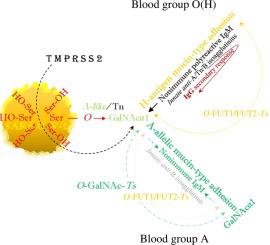Immunobiology ( IF 2.8 ) Pub Date : 2020-11-04 , DOI: 10.1016/j.imbio.2020.152027 Peter Arend 1

|
While the angiotensin converting enzyme 2 (ACE2) protein is defined as the primary severe acute respiratory syndrome coronavirus 2 (SARS-CoV-2) receptor, the viral serine molecule might be mobilized by the host's transmembrane protease serine subtype 2 (TMPRSS2) enzyme from the viral spike (S) protein and hijack the host’s N-acetyl-D-galactosamine (GalNAc) metabolism. The resulting hybrid, serologically A-like/Tn (T nouvelle) structure potentially acts as a host–pathogen functional molecular bridge. In humans, this intermediate structure will hypothetically be replaced by ABO(H) blood group-specific, mucin-type structures, in the case of infection hybrid epitopes, implicating the phenotypically glycosidic accommodation of plasma proteins. The virus may, by mimicking the synthetic pathways of the ABO(H) blood groups, bind to the cell surfaces of the blood group O(H) by formation of a hybrid H-type antigen as the potential precursor of hybrid non-O blood groups, which does not affect the highly anti-glycan aggressive anti-A and anti-B isoagglutinin activities, exerted by the germline-encoded nonimmune immunoglobulin M (IgM). In the non-O blood groups, which have developed from the H-type antigen, these IgM activities are downregulated by phenotypic glycosylation, while adaptive immunoglobulins might arise in response to the hybrid A and B blood group structures, bonds between autologous carbohydrates and foreign peptides, suggesting the exertion of autoreactivity. The non-O blood groups thus become a preferred target for the virus, whereas blood group O(H) individuals, lacking the A/B phenotype-determining enzymes and binding the virus alone by hybrid H-type antigen formation, have the least molecular contact with the virus and maintain the critical anti-A and anti-B isoagglutinin activities, exerted by the ancestral IgM, which is considered the humoral spearhead of innate immunity.
中文翻译:

为什么 A 型血个体处于危险之中,而 O 型血个体则免受 SARS-CoV-2 (COVID-19) 感染:关于病毒如何通过决定 ABO(H) 血型的碳水化合物侵入人体的假设
虽然血管紧张素转换酶 2 (ACE2) 蛋白被定义为主要的严重急性呼吸系统综合症冠状病毒 2 (SARS-CoV-2) 受体,但病毒丝氨酸分子可能会被宿主的跨膜蛋白酶丝氨酸亚型 2 (TMPRSS2) 酶动员病毒刺突 (S) 蛋白并劫持宿主的 N-乙酰-D-半乳糖胺 (GalNAc) 代谢。由此产生的杂交、血清学 A 样/Tn(T nouvelle)结构可能充当宿主-病原体功能分子桥。在人类中,假设这种中间结构将被 ABO(H) 血型特异性粘蛋白型结构取代,在感染杂交表位的情况下,暗示血浆蛋白的表型糖苷调节。该病毒可能通过模仿 ABO(H) 血型的合成途径,通过形成混合 H 型抗原作为混合非 O 血型的潜在前体,与 O(H) 血型的细胞表面结合,这不会影响高度抗聚糖侵袭性抗 A 和抗- B 同种凝集素活性,由种系编码的非免疫免疫球蛋白 M (IgM) 发挥作用。在从 H 型抗原发展而来的非 O 血型中,这些 IgM 活性被表型糖基化下调,而适应性免疫球蛋白可能响应混合 A 和 B 血型结构、自体碳水化合物和外来碳水化合物之间的键合而产生肽,表明自身反应性的发挥。因此,非 O 血型成为病毒的首选目标,而 O(H) 血型个体,



























 京公网安备 11010802027423号
京公网安备 11010802027423号